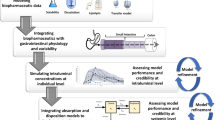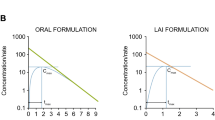Abstract
Purpose
To explore the application of the parameters of the physiologically based finite time pharmacokinetic (PBFTPK) models subdivided in first-order (PBFTPK)1 and zero-order (PBFTPK)0 models to bioavailability and bioequivalence. To develop a methodology for the estimation of absolute bioavailability, F, from oral data exclusively.
Methods
Simulated concentration time data were generated from the Bateman equation and compared with data generated from the (PBFTPK)1 and (PBFTPK)0 models. The blood concentration Cb(τ) at the end of the absorption process τ, was compared to Cmax; the utility of \( {(AUC)}_0^{\tau } \) and \( {(AUC)}_t^{\infty } \) in bioequivalence assessment was also explored. Equations for the calculation of F from oral data were derived for the (PBFTPK)1 and (PBFTPK)0 models. An estimate for F was also derived from an areas proportionality using oral data exclusively.
Results
The simulated data of the (PBFTPK)0 models exhibit rich dynamics encountered in complex drug absorption phenomena. Both (PBFTPK)1 and (PBFTPK)0 models result either in Cmax = Cb(τ) or Cmax > Cb(τ) for rapidly- and not rapidly-absorbed drugs, respectively; in the latter case, Cb(τ) and τ are meaningful parameters for drug’s rate of exposure. For both (PBFTPK)1 and (PBFTPK)0 models, \( {(AUC)}_0^{\tau } \) or portions of it cannot be used as early exposure rate indicators. \( {(AUC)}_{\tau}^{\infty } \) is a useful parameter for the assessment of extent of absorption for very rapidly absorbed drugs. An estimate for F for theophylline formulations was found close to unity.
Conclusion
The (PBFTPK)1 and (PBFTPK)0 models are more akin to in vivo conditions. Estimates for F can be derived from oral data exclusively.






Similar content being viewed by others
Change history
28 September 2021
A Correction to this paper has been published: https://doi.org/10.1007/s11095-021-03101-0
Abbreviations
- BCS:
-
Biopharmaceutic classification system
- PBPK:
-
Physiologically based pharmacokinetics
- PBFTPK:
-
Physiologically based finite time pharmacokinetics
- RMZ:
-
Remimazolam
References
Dost H. Der Blutspiegel. Kinetik der Konzentrationsverläufe in der Kreislaufflüssigkeit. Leipzig. 1953;
Tozer MR and T. Clinical Pharmacokinetics and Pharmacodynamics: Concepts and Applications. 4th ed. 2011.
Bonate PL. Pharmacokinetic-Pharmacodynamic modeling and simulation. 2nd ed. https://doi.org/10.1007/978-1-4419-9485-1, editor. Springer US
Macheras P. On an unphysical hypothesis of Bateman equation and its implications for pharmacokinetics. Vol. 36, Pharmaceutical Research. Springer New York LLC; 2019.
Sugano K. Lost in modelling and simulation? ADMET DMPK. 2021;9(2):75–109.
Sugano K. Biopharmaceutics modeling and simulations: theory, Practice, Methods, and Applications. 2012.
Macheras P, Chryssafidis P. Revising pharmacokinetics of Oral Drug absorption: I models based on biopharmaceutical/physiological and finite absorption time concepts. Pharm Res. 2020 Sep;37(10):187.
Amidon GL, Lennernas H, Shah VP, Crison JR. A theoretical basis for a biopharmaceutic drug classification: the correlation of in vitro drug product dissolution and in vivo bioavailability, Pharm res 12, 413-420, 1995--backstory of BCS. AAPS J. 2014;16(5):894–8.
Food and Drug Administration. Center for Drug Evaluation and Research (CDER). Waiver of In Vivo Bioavailability and Bioequivalence Studies for Immediate-Release Solid Oral Dosage Forms Based on a Biopharmaceutics Classification System. Guidance for Indust. 2017.
European medicines agency. Committee for medicinal products for human use (CHMP) guideline on the investigation of bioequivalence. London, Jan. 2017.Accessed March 10, 2021 2017.
Bateman H. The solution of a system of differential equation soccuring in the theory of radio-active transformations. Proc Cambridge Philos Soc Math Phys Sci [Internet] 1910;11(February):423–7. Available from: http://www.biodiversitylibrary.org/item/108210#page/35/mode/1up
Niazi S. Textbook of biopharmaceutics and clinical pharmacokinetics. 292 Madison Ave., New York
Charalabidis A, Sfouni M, Bergström C, Macheras P. The Biopharmaceutics Classification System (BCS) and the Biopharmaceutics Drug Disposition Classification System (BDDCS): Beyond guidelines. Int J Pharm [Internet]. 2019 May;566:264—281. Available from: https://doi.org/10.1016/j.ijpharm.2019.05.041.
Krzyzanski W, Jusko WJ, Wacholtz MC, Minton N, Cheung WK. Pharmacokinetic and pharmacodynamic modeling of recombinant human erythropoietin after multiple subcutaneous doses in healthy subjects. Eur J Pharm Sci Off J Eur Fed Pharm Sci. 2005;26(3–4):295–306.
Sjögren E, Westergren J, Grant I, Hanisch G, Lindfors L, Lennernäs H, et al. In silico predictions of gastrointestinal drug absorption in pharmaceutical product development: application of the mechanistic absorption model GI-Sim. Eur J Pharm Sci Off J Eur Fed Pharm Sci. 2013;49(4):679–98.
Certara SimcypTM PBPK Simulator | Predicting drug performance.
Macheras P, Karalis V. A non-binary biopharmaceutical classification of drugs: the ABΓ system. Int J Pharm. 2014 Apr;464(1–2):85–90.
Endrenyi L, Fritsch S, Yan W. Cmax/AUC is a clearer measure than Cmax for absorption rates in investigations of bioequivalence. Int J Clin Pharmacol Ther Toxicol. 1991;29(10):394–9.
Chen ML. An alternative approach for assessment of rate of absorption in bioequivalence studies. Pharm Res. 1992;9(11):1380–5.
Chen M-L, Davit B, Lionberger R, Wahba Z, Ahn H-Y, Yu LX. Using partial area for evaluation of bioavailability and bioequivalence. Pharm Res. 2011 Aug;28(8):1939–47.
Macheras P, Symillides M, Reppas C. An improved intercept method for the assessment of absorption rate in bioequivalence studies. Pharm Res. 1996 Nov;13(11):1755–8.
Macheras P, Symillides M, Reppas C. The cutoff time point of the partial area method for assessment of rate of absorption in bioequivalence studies. Pharm Res. 1994 Jun;11(6):831–4.
Soulele K, Macheras P, Silvestro L, Rizea Savu S, Karalis V. Population pharmacokinetics of fluticasone propionate/salmeterol using two different dry powder inhalers. Eur J Pharm Sci [Internet]. 2015;80:33–42 Available from: http://europepmc.org/abstract/MED/26296862.
Soulele K, Macheras P, Karalis V. On the pharmacokinetics of two inhaled budesonide/formoterol combinations in asthma patients using modeling approaches. Pulm Pharmacol Ther. 2018 Feb;48:168–78.
Soulele K, Macheras P, Karalis V. Pharmacokinetic analysis of inhaled salmeterol in asthma patients: evidence from two dry powder inhalers. Biopharm Drug Dispos. 2017 Oct;38(7):407–19.
Bioavailability and Bioequivalence Studies for Nasal Aerosols and Nasal Sprays for Local Action. FDA Guidance. 2003.
Center for Drug Evaluation and Research, Digoxin Bioequivalency Review 76268, https://www.accessdata.fda.gov/drugsatfda_docs/appletter/2002/76268_Digoxin_Approv.pdf
do Carmo Borges N. C., Barrientos Astigarraga R., Sverdloff C. E., Borges B. C., Rodrigues Paiva T., Rebelo Galvinas P., Agnaldo Moreno R., Budesonide quantification by HPLC coupled to atmospheric pressure photoionization (APPI) tandem mass spectrometry. Application to a comparative systemic bioavailability of two budesonide formulations in healthy volunteers, J. Chromatography B 879, 236–242 (2010). https://doi.org/10.1016/j.jchromb.2010.12.003
Pesic M, Schippers F, Saunders R, Webster L, Donsbach M, Stoehr T. Pharmacokinetics and pharmacodynamics of intranasal remimazolam-a randomized controlled clinical trial. Eur J Clin Pharmacol. 2020;76:1505–16. https://doi.org/10.1007/s00228-020-02984-z.
Abuhelwa AY, Foster DJR, Upton RN. A quantitative review and meta-models of the variability and factors affecting Oral` Drug absorption-part II: gastrointestinal transit time. AAPS J. 2016 Sep;18(5):1322–33.
Meyer MC, Jarvi EJ, Straughn AB, Pelsor FR, Williams RL, Shah VP. Bioequivalence of immediate-release theophylline capsules. Biopharm Drug Dispos. 1999 Dec;20(9):417–9.
Hendeles L, Weinberger M, Bighley L. Absolute bioavailability of oral theophylline. Am J Hosp Pharm [Internet]. 1977;34(5):525–7. Available from. https://doi.org/10.1093/ajhp/34.5.525.
Brown J, Chien C, Timmins P, Dennis A, Doll W, Sandefer E, et al. Compartmental Absorption Modeling and Site of Absorption Studies to Determine Feasibility of an Extended-Release Formulation of an HIV-1 Attachment Inhibitor Phosphate Ester Prodrug. J Pharm Sci. 2013;102:1742–51. https://doi.org/10.1002/jps.23476.
Author information
Authors and Affiliations
Corresponding author
Additional information
Publisher’s Note
Springer Nature remains neutral with regard to jurisdictional claims in published maps and institutional affiliations.
Rights and permissions
About this article
Cite this article
Chryssafidis, P., Tsekouras, A.A. & Macheras, P. Revising Pharmacokinetics of Oral Drug Absorption: II Bioavailability-Bioequivalence Considerations. Pharm Res 38, 1345–1356 (2021). https://doi.org/10.1007/s11095-021-03078-w
Received:
Accepted:
Published:
Issue Date:
DOI: https://doi.org/10.1007/s11095-021-03078-w




